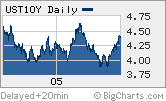 |
 |
| Still a conundrum? Long-term bond yields have moved higher lately but are still below the level they were at when the Fed first started to raise rates. |
|
|
|
| Old conundrum, new twist
|
| Inverted or flat, the yield curve points to a weaker Federal Reserve, not a downturn. (Full story)
|
|
|
|
|
|
|
|
NEW YORK (CNN/Money) -
The Fed is not going to stop raising rates any time soon.
Alan Greenspan and the rest of the central bank's monetary policy committee made that painfully clear on Tuesday when they boosted the federal funds rate for the 10th consecutive time and said once again that rates would go up at a "pace that is likely to be measured."
So what's this mean for investors in bonds? Is the fixed-income rally over?
The yield on the benchmark 10-year U.S. Treasury note has remained relatively low even though short-term rates have risen from 1 percent to 3.5 percent since the Fed started tightening in June 2004.
The bull case for bonds...
But since hitting a year-to-date low yield of 3.8 percent in June, bond prices have fallen, sending the yield on the 10-year up to about 4.38 percent. (Yields and prices move in opposite directions.)
In theory, if the Fed keeps raising rates, the yield on the 10-year Treasury should keep heading higher as well. But will that really be the case? After all, despite the recent sell-off, the yield on the 10-year Treasury is still below the level it was at when the Fed started to raise rates last year.
And bonds have rallied a bit since the Fed's announcement Tuesday. Prior to the release of its statement, the yield on the 10-year Treasury was as high as 4.43 percent.
Tom Higgins, chief economist with Payden & Rygel, an institutional money management firm based in Los Angeles, said there's a better chance of another rally than a big sell-off in the near term. He thinks that the yield on the 10-year won't head higher than 4.5 percent and could even head back towards 4 percent in the coming months.
Higgins argues that even though the Fed indicated more rate hikes are likely, it did not seem overly concerned about the economy overheating, which would be a good sign for longer-term bonds.
"The Fed's statement turned out to be more benign than people were expecting. Before the meeting, people were thinking the Fed would be more hawkish but their comments seemed to suggest that they were not overly concerned about inflation," Higgins said.
Others believe that bonds will resume their sell-off because there appears to be no sign of an economic slowdown looming. As such, fixed-income investors are now begrudgingly realizing that they cannot fight the Fed.
...and the bear case
"The market has been dragged kicking and screaming to the conclusion that rates will be raised for the end of the year," said Steve Van Order, chief fixed income strategist with Calvert Funds in Baltimore. "Investors are locked in now on a 4.25 percent fed funds rate."
Nonetheless, few expect yields to surge dramatically higher since there still seems to be heavy interest in U.S. Treasuries by foreign central banks. This demand should keep longer-term rates below 5 percent, said Van Order.
The big wild card, of course, will be what the economic data for the rest of the year looks like. If there's more evidence of inflation, such as even higher oil prices or several more strong monthly labor reports, then that could send bond yields dramatically higher. But if inflation stays under control, bond yields are unlikely to move much from current levels.
To that end, Tony Rodriguez, head of fixed income at First American Funds in Minneapolis, said he thinks longer-term bonds will probably sell-off between now and the end of the year but that it won't be "in cataclysmic fashion." He thinks 10-year yields could finish at 4.75 percent by year's end.
"Inflation will remain well-contained and we should see some moderation, but not weakness, in the pace of economic growth. Combine those two things and higher rates are coming," he said.
Van Order agreed, saying that bonds are probably going to be in what he calls a "gentle bear market" as opposed to an "angry bear market" characterized by substantially higher yields. But the only justification for a significant bond rally would be evidence that the economy is on the verge of a recession. And that doesn't appear to be in the cards.
"If you don't think the wheel is going to fall off the economy then you would think that long-term rates are going to have to head higher," he said.
And for this reason, Rodriguez said his firm is recommending that investors put more money into stocks than bonds at this point. "Equities should outperform fixed-income over the next six to twelve months," he said.
For a look at bond rates, click here.
For more economic news, click here.

|